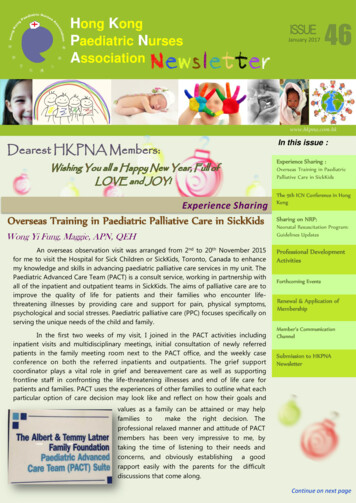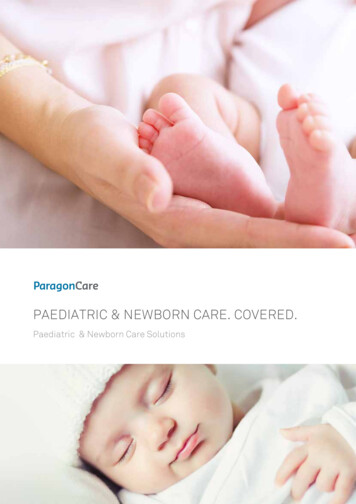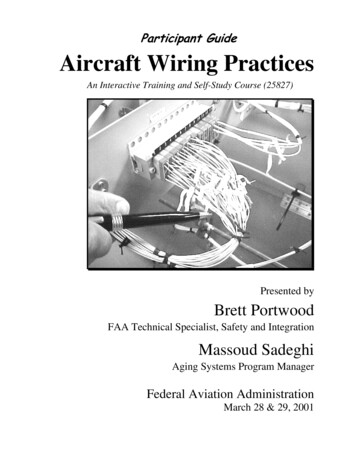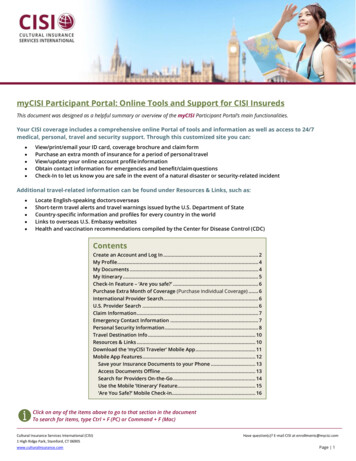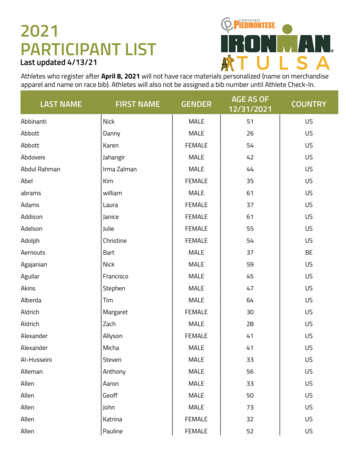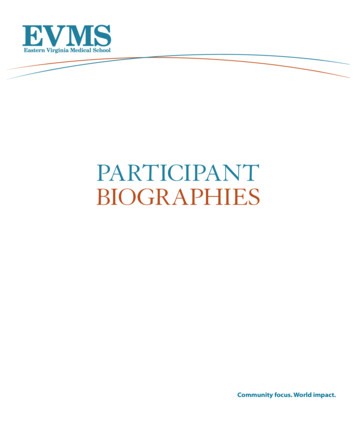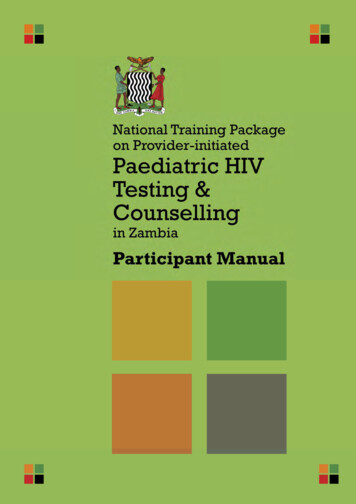
Transcription
PAEDIATRIC PITC PARTICIPANT MANUALINTRODUCTION-i
Foreword and AcknowledgementsNational Training Package for Paediatric Provider-initiatedHIV Testing and CounsellingApproximately 95,000 children aged 0 to 14 years in Zambia live with HIV. Themajority of these children are unaware of their HIV status. As one of the mostaffected nations in sub-Saharan Africa, there is a dire need to implement servicesto identify, care and treat HIV infection in children and families. This trainingpackage was developed by the Ministry of Health (MoH) to support theimplementation and scale up of paediatric provider-initiated HIV testing andcounselling (PITC) services nationally. PITC is the routine testing of children asthe first step in determining HIV status, which is the gateway to accessingtreatment and preventing rapid progress of the disease.The Government of the Republic of Zambia is committed to providing equitableaccess to quality health care which includes universal access to anti-retroviraltherapy (ART) for adults and children. This training package supports the nationwide scale-up of paediatric PITC. The training is meant for the range ofhealthcare workers in all settings who come in contact with and provide servicesfor caregivers and their children — e.g. lay counselors, community healthworkers, nurses, nurse counselors, midwives, clinical officers, medical licentiates,paediatricians, physicians (non-paediatrician), programme managers, facilitymanagers and district or provincial supervisors.AcknowledgementsThe guidelines were developed by Dr. Chipepo Kankasa on behalf of the Ministryof Health. The MoH would like to acknowledge collaboration with and supportfrom the International Center for AIDS Care and Treatment Programmes (ICAP) ofColumbia University Mailman School of Public Health, including Dr. ElaineAbrams, Cristiane Costa, Ruby Fayorsey, Nancy Briggs, Leah Westra andindependent consultant Tayla Colton. MoH would also like to acknowledge thecontributions of the personnel at the University Teaching Hospital’s Department ofPaediatrics HIV Centre of Excellence (PCOE) for their technical expertise andleadership in initiating PITC services and developing the paediatric PITCguidelines and training package, including Mr. Kwapa, Mr. Silavwe, CounsellorsFebby Banda-Kawamya, Rodia Chilufya, Joyce Mwanan’gombe, Ruth Katuta andPCOE monitoring and evaluation expert Katai Chola. The MoH would like tothank the François Xavier Bagnoud (FXB) Center, School of Nursing, University ofMedicine and Dentistry of New Jersey, for coordinating development of theguidelines, including Mary Jo Hoyt, Deanne Samuels, Beth Hurley, Daina Bungsand Virginia Allread.Development of the guidelines was supported by funding from the U.S. Centersfor Disease Control and Prevention Global AIDS Program through the President’sEmergency Plan for AIDS Relief.PAEDIATRIC PITC PARTICIPANT MANUALINTRODUCTION-i
Abbreviations and PMTCTQARFTLamivudineAcquired immune deficiency syndromeAverage monthly consumptionAnti-retroviral therapyAnti-retroviralAnti-tuberculosis treatmentZidovudineBacille Calmette-GuérinBaby Friendly Hospital InitiativeT-lymphocyte CD4 countCotrimoxazoleDried blood spotDeoxyribonucleic acidDiphtheria, pertussis, tetanusExclusive breastfeedingEfavirenzEarly infant diagnosisExpanded Programme on ImmunisationsFull blood countGovernment of the Republic of ZambiaHepatitis BHaemophilus influenzae type bHuman immunodeficiency virusIsoniazidIntermittent presumptive therapyInfant and young child feedingLiver function testLogistics Management SystemLogistics Management Information SystemNevirapineMonitoring and evaluationMaternal child healthMeasles-mumps-rubellaMinistry of HealthMother-to-child transmission (of HIV)Obstetrician / gynaecologistOral polioPaediatric HIV Centre of ExcellencePolymerase chain reactionPneumococcal conjugatePost-exposure prophylaxisProvider-initiated testing and counsellingPeople living with HIVPrevention of mother-to-child transmission (of HIV)Quality assuranceRenal function testii-INTRODUCTIONPAEDIATRIC PITC PARTICIPANT MANUAL
ard operating procedureSexually transmitted infectionTuberculosisTrimethoprimTraining of trainersJoint United Nations Programme on HIV/AIDSUniversity Teaching HospitalWorld Health OrganizationPAEDIATRIC PITC PARTICIPANT MANUALINTRODUCTION-iii
Table of ContentsModule 1: Introduction and Course Overview . 1-1Module 2: Review of MTCT and PMTCT. 2-1Module 3: Review of Infant and Young Child Feeding . 3-1Module 4: Overview of Paediatric HIV Testing and Counselling . 4-1Module 5: Pre- and Post-test Counselling for Paediatric HIV Testing . 5-1Module 6: HIV Testing in Children. 6-1Module 7: Ongoing Care, Treatment and Supportive Counsellingfor the Child and Family . 7-1Module 8: Record Keeping, Monitoring and Quality Assurance . 8-1Module 9: Paediatric PITC Action Planning and Implementation . 9-1Module 10: Supervised Clinical Practicum and Action Planning.10-1Module 11: Training Review, Evaluation and Closing.11-1iv-INTRODUCTIONPAEDIATRIC PITC PARTICIPANT MANUAL
Module 1Introduction and CourseOverviewTotal Module Time:120 minutes (2 hours)Learning ObjectivesAfter completing this module, participants will be able to: Describe the objectives of the training. Understand the training agenda, including classroom andhospital-based sessions. Introduce the trainers and other training participants. Understand the ground rules and daily training activities. Complete the Pre-test.Session 1.1: Course OverviewSession 1.2: Introductions and Ground RulesSession 1.3: Pre-testPAEDIATRIC PITC PARTICIPANT MANUALMODULE 1-1
Session 1.1Course OverviewSession ObjectivesAfter completing this session, participants will be able to: Describe the objectives of the training. Understand the training agenda, including classroom and hospitalbased sessions.Target Audience for the TrainingThis training course is targeted to healthcare workers, managers and othermembers of the multidisciplinary team working in (or intending to workin): Paediatric hospital wards, including nurseries Any inpatient hospital ward with paediatric patients Under-five clinics PMTCT clinics Malnutrition clinics TB clinics Outpatient clinics with children or a mix of children and adultsThe training is intended to be multidisciplinary, with a focus on: Lay counsellors Community health workers Nurse counsellors Nurses Midwives Clinical officers Medical licentiates Paediatricians Physicians (non-paediatrician) Programme managers Facility managers District or provincial supervisorsBackgroundIn Zambia, an estimated 95,000 children are living with HIV; 90% of thesechildren were infected through mother-to-child transmission of HIV(MTCT).Without treatment, 30% of HIV-infected infants will die before their firstbirthday, and 50% before their second birthday. The goal of testing for HIVinfection as early as possible is to identify HIV-exposed and HIV-infectedchildren early and engage them in life-saving care and treatment. Earlyaccess to HIV care and treatment can delay disease progression, improvehealth and prevent death.MODULE 1-2PAEDIATRIC PITC PARTICIPANT MANUAL
The MoH is rolling out a paediatric provider-initiated HIV testing andcounselling (PITC) strategy nationwide. This strategy is discussed in depthin Module 4. In addition to HIV testing and counselling of all children ofmothers living with HIV (i.e. HIV-exposed children), the PITC strategyrecommends phased implementation of paediatric PITC, with priorityplaced on children most likely to be HIV-exposed or –infected: Children that are hospitalised (for any reason) Children presenting at TB clinics or malnutrition clinics Children less than 5 years of age Children of adults accessing HIV services Children known or suspected to have been sexually abusedThe MoH recommends that paediatric PITC be provided at: Paediatric hospital wards, including malnutrition wards Any inpatient hospital ward with paediatric patients Under-five clinics PMTCT clinics Malnutrition clinics TB clinics Outpatient clinics with paediatric patientsPaediatric PITC Training ObjectivesBy the end of this training participants will be able to:1. Explain the rationale for paediatric PITC and the benefits of diagnosingHIV as early as possible.2. Define family-focused care and describe how paediatric HIV testingand counselling can be the entry point to care for the entire family.3. Demonstrate an understanding of the national guidelines on HIV testingand counselling, including PITC and age-specific HIV testingalgorithms.4. Conduct the group and individual HIV pre-test session with caregiversand children.5. Conduct rapid HIV testing on children and interpret the results,according to national guidelines.6. Provide post-test counselling, according to national guidelines.7. Collect DBS samples for DNA PCR testing on children and interpret theresults, according to national guidelines.8. Provide infant and young child feeding education, counselling andsupport, according to national guidelines.9. Actively link HIV-exposed and HIV-infected children, mothers andfamily members with needed care, support and treatment services.Monitor and support adherence to follow-up appointments.10. Provide caregivers, children and family members with ongoingsupportive counselling.11. Collect and analyse routine data on paediatric testing and counsellingand put quality assurance measures in place.12. Develop a site-specific action plan for implementing paediatric PITC.PAEDIATRIC PITC PARTICIPANT MANUALMODULE 1-3
Training Syllabus and AgendaThe training includes 11 modules, each with its own learning objectives.Each module is divided into sessions. Module 1: Introduction and Course Overview Module 2: Review of MTCT and PMTCT Module 3: Review of Infant and Young Child Feeding Module 4: Overview of Paediatric HIV Testing and Counselling Module 5: Pre- and Post-test Counselling for Paediatric HIV Testing Module 6: HIV Testing in Children Module 7: Ongoing Care, Treatment and Supportive Counselling for theChild and Family Module 8: Record Keeping, Monitoring and Quality Assurance Module 9: Paediatric PITC Action Planning and Implementation Module 10: Supervised Clinical Practicum and Action Planning Module 11: Training Review, Evaluation and ClosingSee the Training Agenda in Appendix 1-A.MODULE 1-4PAEDIATRIC PITC PARTICIPANT MANUAL
Session 1.2Introductions and GroundRulesSession ObjectivesAfter completing this session, participants will be able to: Introduce the trainers and other training participants. Understand the ground rules and daily training activities.Exercise 1: Getting to know each otherPurpose To create a comfortable learning environment To provide an opportunity to get to know each otherIntroductionThis is an activity that will provide an opportunity forparticipants get to know each other better. Participantswill also be asked to write the following on a card orsheet of paper: Concerns: What concerns or worries do you haveabout taking care of women, children and familieswith HIV? Expectations: What do you hope to learn from thiscourse? Strengths: What three personal strengths do youbring to your work?The cards/sheets of paper will not be collected.Exercise 2: Setting ground rules and introducing daily activitiesPurpose To develop and agree on a set of ground rules thatwill create an environment that facilitates learning To introduce the “Anonymous Question Bowl” as asafe space for asking questions To introduce the “Morning Rounds” as a way to starteach day of the training To introduce the “How did it go?” daily evaluationactivity as a way to give feedback to the trainersduring the training courseIntroductionAlthough the training is about HIV testing andcounselling services for children, to be successful thismust be a safe space for sharing and learning.Agreeing on ground rules and opportunities forproviding feedback are first steps to creating a safespace.PAEDIATRIC PITC PARTICIPANT MANUALMODULE 1-5
Session 1.3Pre-testSession ObjectivesAfter completing this session, participants will be able to: Complete the Pre-test.Exercise 3: Pre-TestPurpose To assess participant knowledge before the trainingcourseIntroductionParticipants will be given 30 minutes to take the Pretest. The same test will be re-administered at the end ofthe course, when it will be referred to as the Post-test.The results of the Pre-test will give a picture of currentknowledge. At the end of the course, results of the Pretest will be compared with the Post-test to quantify howmuch participants learned during the training, helpassess how well the training met its objectives, andprovide information to improve future trainings.MODULE 1-6PAEDIATRIC PITC PARTICIPANT MANUAL
Appendix 1-ATraining AgendaPaediatric Provider-initiated HIV Testing and CounsellingTraining ProgrammeWEEK 1: Classroom-based Training and Observation in Wards*Day 1Morning Participant Registration & IntroductionSession Opening of the Training Module 1: Introduction and Course Overview Module 2: Review of MTCT and PMTCTAfternoon Module 2, continuedSession Module 3: Review of Infant and Young Child Feeding Wrap-Up & Daily EvaluationDay 2Morning “Morning Rounds” & Overview of the DaySession Tour & Ward Observation Module 3, continued Module 4: Overview of Paediatric HIV Testing andCounsellingAfternoon Module 4, continuedSession Module 5: Pre- and Post-test Counselling for PaediatricHIV Testing Wrap-Up & Daily EvaluationDay 3Morning “Morning Rounds” & Overview of the DaySession Observation in Wards Module 5, continuedAfternoon Module 6: HIV Testing in ChildrenSession Wrap-Up & Daily EvaluationDay 4Morning “Morning Rounds” & Overview of the DaySession Observation in Wards Module 7: Ongoing Care, Treatment and SupportiveCounselling for the Child and FamilyAfternoon Module 8: Record Keeping, Monitoring and QualitySessionAssurance Wrap-Up & Daily EvaluationDay 5Morning “Morning Rounds” & Overview of the DaySession Observation in Wards Module 9: Paediatric PITC Action Planning andImplementation Module 10: Supervised Clinical Practicum and ActionPlanning (Session 10.1 only) Wrap-Up & Daily EvaluationPAEDIATRIC PITC PARTICIPANT MANUALMODULE 1-7
WEEK 2: Hospital-based Practicum and Implementation PlanningDay 6Morning “Morning Rounds” & Practicum PlanningSession Practical Sessions in WardsAfternoon Practical Sessions in WardsSession Debrief & Daily EvaluationDay 7Morning “Morning Rounds” & Practicum PlanningSession Practical Sessions in WardsAfternoon Practical Sessions in WardsSession Debrief & Daily EvaluationDay 8Morning “Morning Rounds” & Practicum PlanningSession Practical Sessions in WardsAfternoon Practical Sessions in WardsSession Debrief & Daily EvaluationDay 9Morning “Morning Rounds” & Practicum PlanningSession Practical Sessions in Wards Practicum debriefAfternoon Module10: Supervised Clinical Practicum and ActionSessionPlanning, continued Debrief & Daily EvaluationDay 10Morning “Morning Rounds” & Overview of the DaySession Module 11: Training Review, Evaluation and Closing Presentation of Training Certificates & Closing*Note that the training agenda and times are approximate and can be modified based onward and clinic activities.MODULE 1-8PAEDIATRIC PITC PARTICIPANT MANUAL
Module 2Review of MTCT andPMTCTTotal Module Time:135 minutes (2 hour, 15 minutes)Learning ObjectivesAfter completing this module, participants will be able to: Discuss basic concepts of mother-to-child transmission(MTCT), including timing of transmission and risk factorsassociated with MTCT. Demonstrate understanding of the national PMTCT strategy. Describe key interventions to reduce the risk of MTCT duringpregnancy, labour, delivery and postpartum duringbreastfeeding. Describe needed follow-up services for HIV-exposedchildren and their mothers, including paediatric HIV testingand counselling.Session 2.1: Mother-to-Child Transmission of HIVInfectionSession 2.2: Comprehensive Approach to Prevention ofHIV Infection in ChildrenPAEDIATRIC PITC PARTICIPANT MANUALMODULE 2-1
Session 2.1Mother-to-Child Transmissionof HIV InfectionSession ObjectiveAfter completing this session, participants will be able to: Discuss basic concepts of mother-to-child transmission (MTCT),including timing of transmission and risk factors associated with MTCT.MTCTAbout 16% of all pregnant women in Zambia are living with HIV. It isestimated that about 95,000 children are currently living with HIV, andmore than 90% of these infections are the result of MTCT. MTCT is alsoreferred to as “vertical transmission” or “perinatal transmission”.Use of the term MTCT attaches no blame or stigma to the woman who givesbirth to a child who is HIV-infected. It does not suggest deliberatetransmission by the mother, who may be unaware of her own infectionstatus and unfamiliar with how HIV is passed from mother to child.Risk of MTCTMTCT can occur during: Pregnancy Labour and delivery BreastfeedingAmong women with HIV who are not receiving ARVs and who breastfeed,as much as 25–50% of MTCT occurs during breastfeeding. The use of ARVsduring pregnancy, labour, delivery and post-partum during breastfeedinghas a major impact on reducing the risk of transmission.Figure 2.1 shows that without intervention, 20–45% of infants born tomothers living with HIV who breastfeed become HIV-infected. PMTCTinterventions can reduce transmission to levels as low as 1–10%,depending on the interventions available.MODULE 2-2PAEDIATRIC PITC PARTICIPANT MANUAL
Figure 2.1: Estimated HIV outcomes of infants born to women livingwith HIV (with no PMTCT intervention)55–80 infantswill not beHIV-infected100 infants born to women living with HIV whobreastfeed, without any 0–15infantsinfectedduringlabour g20–45 infants will be HIV-infectedNote: This figure gives an overall picture of possible outcomes. There will bevariability among different populations and for particular mother-infant pairs.Risk Factors for MTCTViral, maternal, obstetrical, foetal and infant-related factors all influencethe risk of MTCT. ARVs dramatically reduce risk of MTCT by lowering theamount of HIV in the mother’s blood. TheThe most important risk factormost important risk factors for MTCTfor MTCT is advanced HIVduring pregnancy, labour, delivery andand new HIV infection in thebreastfeeding are as follows:mother — when the amount of Advanced HIV infectionHIV in the mother’s blood is Advanced infection, includinghigh.AIDS, occurs when an individual’sCD4 count drops and the body is no longer able to fight off infection.The individual is more likely to have opportunistic infections, suchas PCP (pneumocystis pneumonia). High viral load, that is, when the amount of virus in the blood is high.Viral load is typically high when a woman is newly infected with HIVand when she has advanced HIV disease (low CD4 cell count andsymptoms of severe disease both indicate that viral load is probablyhigh). ARVs are used to reduce viral load. No use of ARVs during pregnancy, labour, delivery and post-partumduring breastfeeding.Other factors that increase risk of MTCT are listed in Table 2.1.PAEDIATRIC PITC PARTICIPANT MANUALMODULE 2-3
Table 2.1: Factors that increase the risk of MTCT during pregnancy,labour and deliver
PAEDIATRIC PITC PARTICIPANT MANUAL MODULE 1-3 The MoH is rolling out a paediatric provider-initiated HIV testing and counselling (PITC) strategy nationwide. This strategy is discussed in depth in Module 4. In addition to HIV testing and counselling of all children of mothers living with HIV (i.e.
